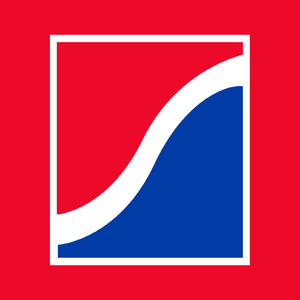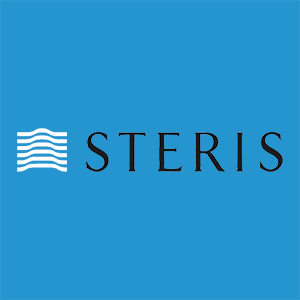
Zimmer Biomet (ZBH)
We’re skeptical of Zimmer Biomet. Its sales have underperformed and its low returns on capital show it has few growth opportunities.― StockStory Analyst Team
1. News
2. Summary
Why Zimmer Biomet Is Not Exciting
With a history dating back to 1927 and a presence in over 100 countries worldwide, Zimmer Biomet (NYSE:ZBH) designs and manufactures orthopedic products including knee and hip replacements, surgical tools, and robotic technologies for joint reconstruction and spine surgeries.
- Underwhelming 4.2% return on capital reflects management’s difficulties in finding profitable growth opportunities
- Muted 3% annual revenue growth over the last five years shows its demand lagged behind its healthcare peers
- A silver lining is that its earnings per share have outperformed its peers over the last five years, increasing by 23.2% annually


Zimmer Biomet’s quality isn’t up to par. There’s a wealth of better opportunities.
Why There Are Better Opportunities Than Zimmer Biomet
High Quality
Investable
Underperform
Why There Are Better Opportunities Than Zimmer Biomet
Zimmer Biomet’s stock price of $93.08 implies a valuation ratio of 11.2x forward P/E. Zimmer Biomet’s multiple may seem like a great deal among healthcare peers, but we think there are valid reasons why it’s this cheap.
Our advice is to pay up for elite businesses whose advantages are tailwinds to earnings growth. Don’t get sucked into lower-quality businesses just because they seem like bargains. These mediocre businesses often never achieve a higher multiple as hoped, a phenomenon known as a “value trap”.
3. Zimmer Biomet (ZBH) Research Report: Q3 CY2025 Update
Medical device company Zimmer Biomet (NYSE:ZBH) met Wall Streets revenue expectations in Q3 CY2025, with sales up 9.7% year on year to $2.00 billion. Its non-GAAP profit of $1.90 per share was 2.1% above analysts’ consensus estimates.
Zimmer Biomet (ZBH) Q3 CY2025 Highlights:
- Revenue: $2.00 billion vs analyst estimates of $2.01 billion (9.7% year-on-year growth, in line)
- Adjusted EPS: $1.90 vs analyst estimates of $1.86 (2.1% beat)
- Management reiterated its full-year Adjusted EPS guidance of $8.20 at the midpoint
- Operating Margin: 17.6%, up from 15.3% in the same quarter last year
- Free Cash Flow Margin: 13.9%, down from 17% in the same quarter last year
- Constant Currency Revenue rose 8.6% year on year (4.1% in the same quarter last year)
- Market Capitalization: $20.44 billion
Company Overview
With a history dating back to 1927 and a presence in over 100 countries worldwide, Zimmer Biomet (NYSE:ZBH) designs and manufactures orthopedic products including knee and hip replacements, surgical tools, and robotic technologies for joint reconstruction and spine surgeries.
The company's product portfolio spans several categories, with knee and hip replacements forming its core business. These implants are used in both primary procedures (first-time replacements) and revision surgeries when existing implants need replacement. Zimmer Biomet's flagship products include the Persona Knee system and the Taperloc Hip System, designed to improve patient mobility and quality of life.
Beyond joint replacements, Zimmer Biomet offers a comprehensive range of Sports Medicine, Extremities, and Trauma (S.E.T.) products. These include devices for repairing soft tissue injuries in knees and shoulders, biologics for joint preservation, implants for foot, ankle, shoulder, elbow, and wrist conditions, and trauma products that stabilize broken bones.
Surgeons use Zimmer Biomet's products to treat patients suffering from arthritis, sports injuries, traumatic injuries, and congenital disorders. For example, an active 65-year-old with severe knee osteoarthritis might receive a Persona Knee implant to reduce pain and restore mobility, allowing them to return to daily activities.
The company has embraced digital innovation through its ZBEdge Platform, which connects robotic technologies like the ROSA Robot with digital tools to collect data throughout the surgical journey. This helps surgeons make more informed decisions about patient care.
Zimmer Biomet sells its products through two main channels: directly to healthcare institutions like hospitals and ambulatory surgery centers, and through distributors and dealers. The company maintains a global presence with operations divided into three segments: Americas (primarily the United States), Europe/Middle East/Africa, and Asia Pacific, with Japan being its largest Asian market.
4. Surgical Equipment & Consumables - Diversified
The surgical equipment and consumables industry provides tools, devices, and disposable products essential for surgeries and medical procedures. These companies therefore benefit from relatively consistent demand, driven by the ongoing need for medical interventions, recurring revenue from consumables, and long-term contracts with hospitals and healthcare providers. However, the high costs of R&D and regulatory compliance, coupled with intense competition and pricing pressures from cost-conscious customers, can constrain profitability. Over the next few years, tailwinds include aging populations, which tend to need surgical interventions at higher rates. The increasing integration of AI and robotics into surgical procedures could also create opportunities for differentiation and innovation. However, the industry faces headwinds including potential supply chain vulnerabilities, evolving regulatory requirements, and more widespread efforts to make healthcare less costly.
Zimmer Biomet's main competitors in the orthopedic medical device market include Johnson & Johnson's DePuy Synthes division, Stryker Corporation, and Smith & Nephew plc, all of which compete across similar product categories including joint replacements and surgical technologies.
5. Economies of Scale
Larger companies benefit from economies of scale, where fixed costs like infrastructure, technology, and administration are spread over a higher volume of goods or services, reducing the cost per unit. Scale can also lead to bargaining power with suppliers, greater brand recognition, and more investment firepower. A virtuous cycle can ensue if a scaled company plays its cards right.
With $8.01 billion in revenue over the past 12 months, Zimmer Biomet has decent scale. This is important as it gives the company more leverage in a heavily regulated, competitive environment that is complex and resource-intensive.
6. Revenue Growth
A company’s long-term sales performance is one signal of its overall quality. Any business can experience short-term success, but top-performing ones enjoy sustained growth for years. Unfortunately, Zimmer Biomet’s 3.8% annualized revenue growth over the last five years was tepid. This was below our standard for the healthcare sector and is a poor baseline for our analysis.

We at StockStory place the most emphasis on long-term growth, but within healthcare, a half-decade historical view may miss recent innovations or disruptive industry trends. Zimmer Biomet’s annualized revenue growth of 4.9% over the last two years is above its five-year trend, but we were still disappointed by the results. 
We can dig further into the company’s sales dynamics by analyzing its constant currency revenue, which excludes currency movements that are outside their control and not indicative of demand. Over the last two years, its constant currency sales averaged 5.2% year-on-year growth. Because this number aligns with its normal revenue growth, we can see that Zimmer Biomet has properly hedged its foreign currency exposure. 
This quarter, Zimmer Biomet grew its revenue by 9.7% year on year, and its $2.00 billion of revenue was in line with Wall Street’s estimates.
Looking ahead, sell-side analysts expect revenue to grow 7.4% over the next 12 months, an improvement versus the last two years. This projection is above the sector average and suggests its newer products and services will catalyze better top-line performance.
7. Operating Margin
Zimmer Biomet has done a decent job managing its cost base over the last five years. The company has produced an average operating margin of 14.5%, higher than the broader healthcare sector.
Analyzing the trend in its profitability, Zimmer Biomet’s operating margin rose by 2.5 percentage points over the last five years, as its sales growth gave it operating leverage. This performance was mostly driven by its recent improvements as the company’s margin has increased by 4.3 percentage points on a two-year basis.

In Q3, Zimmer Biomet generated an operating margin profit margin of 17.6%, up 2.2 percentage points year on year. This increase was a welcome development and shows it was more efficient.
8. Earnings Per Share
Revenue trends explain a company’s historical growth, but the long-term change in earnings per share (EPS) points to the profitability of that growth – for example, a company could inflate its sales through excessive spending on advertising and promotions.
Zimmer Biomet’s EPS grew at an astounding 23.2% compounded annual growth rate over the last five years, higher than its 3.8% annualized revenue growth. This tells us the company became more profitable on a per-share basis as it expanded.
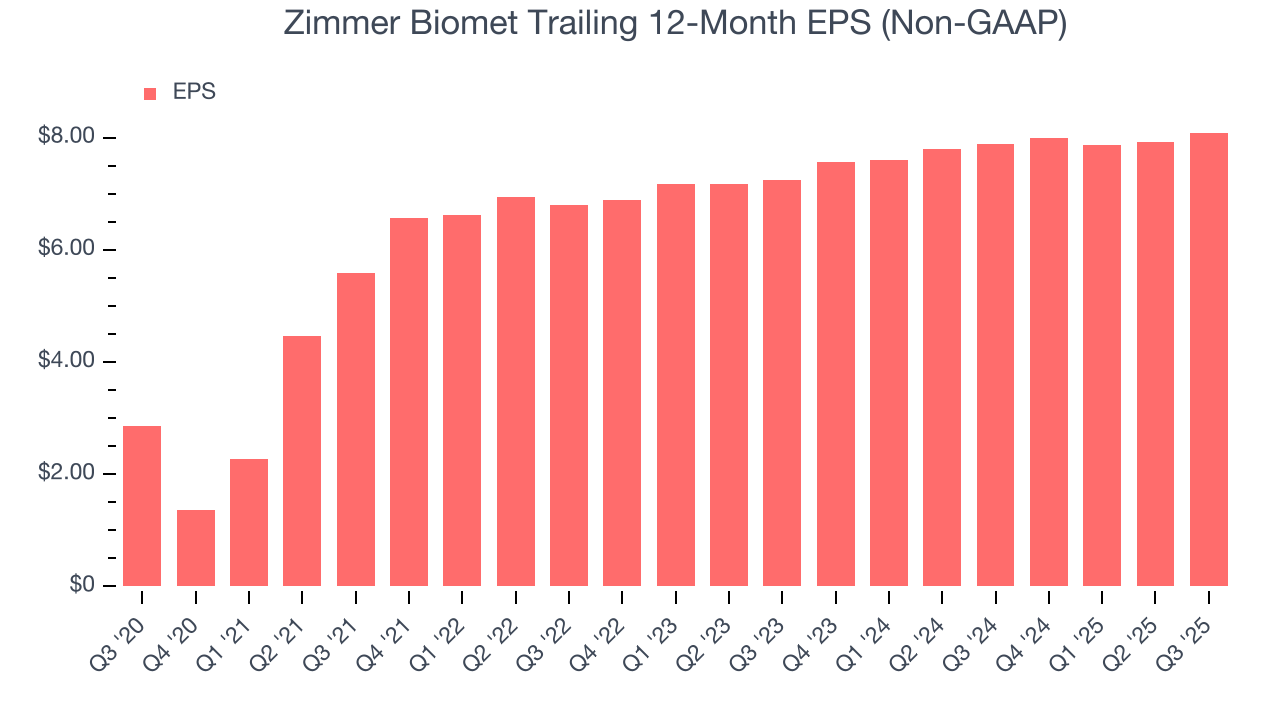
Diving into Zimmer Biomet’s quality of earnings can give us a better understanding of its performance. As we mentioned earlier, Zimmer Biomet’s operating margin expanded by 2.5 percentage points over the last five years. On top of that, its share count shrank by 4.7%. These are positive signs for shareholders because improving profitability and share buybacks turbocharge EPS growth relative to revenue growth. 
In Q3, Zimmer Biomet reported adjusted EPS of $1.90, up from $1.74 in the same quarter last year. This print beat analysts’ estimates by 2.1%. Over the next 12 months, Wall Street expects Zimmer Biomet’s full-year EPS of $8.09 to grow 4.7%.
9. Cash Is King
If you’ve followed StockStory for a while, you know we emphasize free cash flow. Why, you ask? We believe that in the end, cash is king, and you can’t use accounting profits to pay the bills.
Zimmer Biomet has shown impressive cash profitability, giving it the option to reinvest or return capital to investors. The company’s free cash flow margin averaged 13.8% over the last five years, better than the broader healthcare sector.
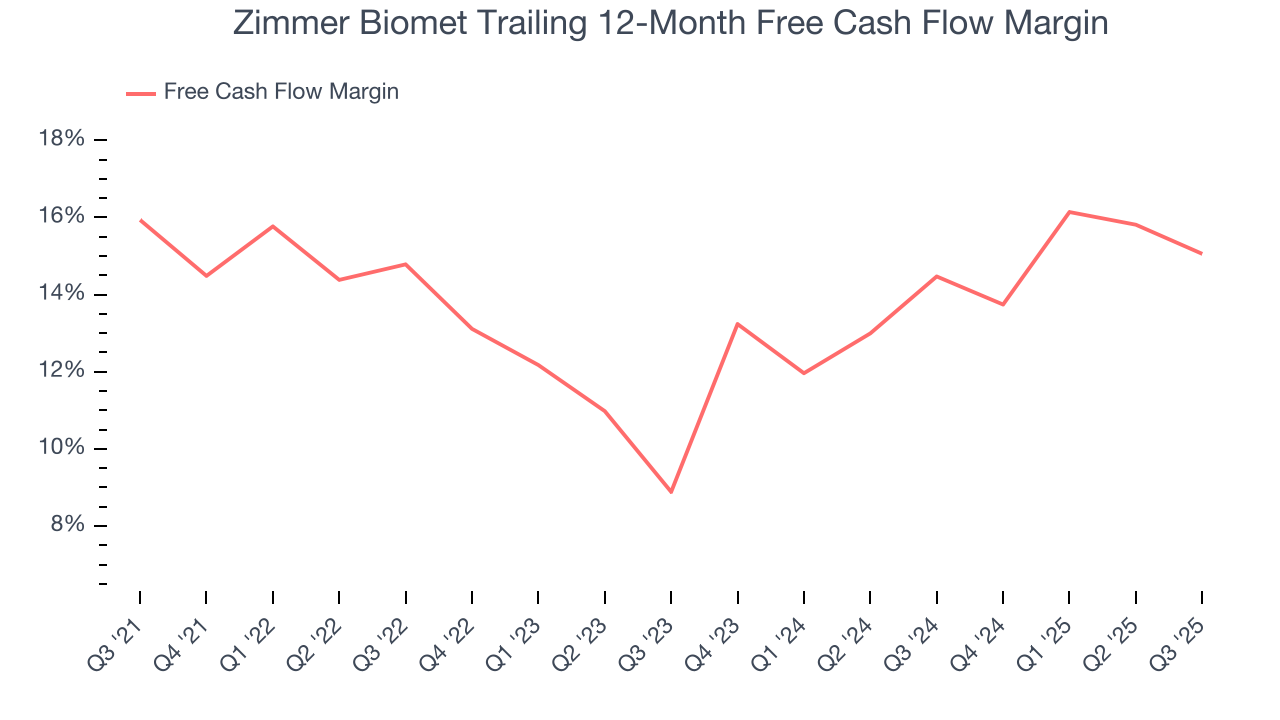
Zimmer Biomet’s free cash flow clocked in at $277.6 million in Q3, equivalent to a 13.9% margin. The company’s cash profitability regressed as it was 3.1 percentage points lower than in the same quarter last year, prompting us to pay closer attention. Short-term fluctuations typically aren’t a big deal because investment needs can be seasonal, but we’ll be watching to see if the trend extrapolates into future quarters.
10. Return on Invested Capital (ROIC)
EPS and free cash flow tell us whether a company was profitable while growing its revenue. But was it capital-efficient? Enter ROIC, a metric showing how much operating profit a company generates relative to the money it has raised (debt and equity).
Zimmer Biomet historically did a mediocre job investing in profitable growth initiatives. Its five-year average ROIC was 4.2%, lower than the typical cost of capital (how much it costs to raise money) for healthcare companies.

We like to invest in businesses with high returns, but the trend in a company’s ROIC is what often surprises the market and moves the stock price. Over the last few years, Zimmer Biomet’s ROIC averaged 1.7 percentage point increases each year. This is a good sign, and if its returns keep rising, there’s a chance it could evolve into an investable business.
11. Balance Sheet Assessment
Zimmer Biomet reported $1.29 billion of cash and $8.11 billion of debt on its balance sheet in the most recent quarter. As investors in high-quality companies, we primarily focus on two things: 1) that a company’s debt level isn’t too high and 2) that its interest payments are not excessively burdening the business.
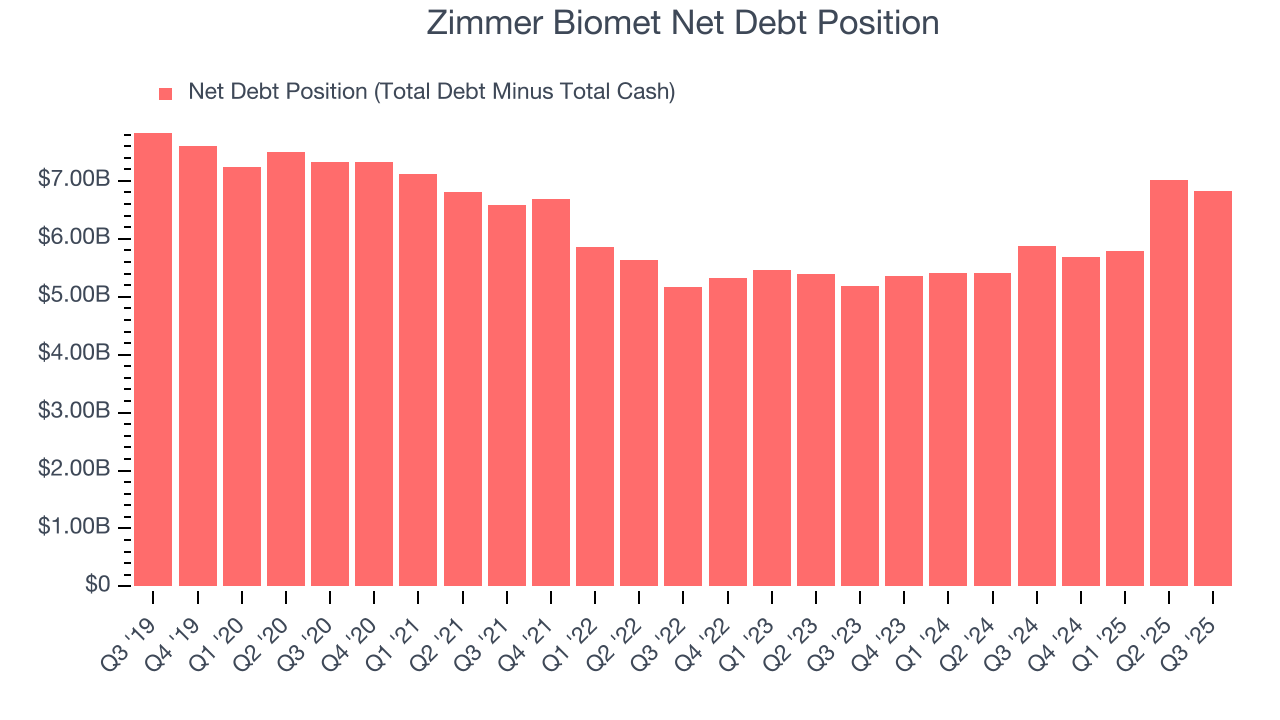
With $3.05 billion of EBITDA over the last 12 months, we view Zimmer Biomet’s 2.2× net-debt-to-EBITDA ratio as safe. We also see its $282.8 million of annual interest expenses as appropriate. The company’s profits give it plenty of breathing room, allowing it to continue investing in growth initiatives.
12. Key Takeaways from Zimmer Biomet’s Q3 Results
It was good to see Zimmer Biomet narrowly top analysts’ full-year EPS guidance expectations this quarter. On the other hand, its revenue was in line. Overall, this was a mixed quarter. The stock traded down 8.8% to $94.10 immediately following the results.
13. Is Now The Time To Buy Zimmer Biomet?
Updated: December 3, 2025 at 10:54 PM EST
We think that the latest earnings result is only one piece of the bigger puzzle. If you’re deciding whether to own Zimmer Biomet, you should also grasp the company’s longer-term business quality and valuation.
Zimmer Biomet isn’t a terrible business, but it doesn’t pass our bar. First off, its revenue growth was uninspiring over the last five years. And while Zimmer Biomet’s astounding EPS growth over the last five years shows its profits are trickling down to shareholders, its mediocre ROIC lags the market and is a headwind for its stock price.
Zimmer Biomet’s P/E ratio based on the next 12 months is 11.2x. This valuation multiple is fair, but we don’t have much faith in the company. We're pretty confident there are more exciting stocks to buy at the moment.
Wall Street analysts have a consensus one-year price target of $102.92 on the company (compared to the current share price of $93.08).

